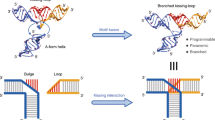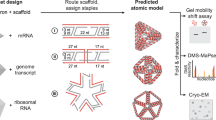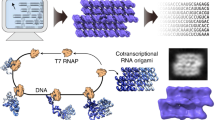Abstract
At the molecular level, translation refers to the production of a new entity according to a template that has a different chemical composition. In this way, chemical information may be translated from one molecule to another. The process is useful to synthesize structures and thus functions that might be difficult to create otherwise, and it reaches exquisite levels of efficiency in biological systems, as illustrated by protein expression from mRNA templates1,2 or by the assembly of the tobacco mosaic virus capsid protein according to the length of its RNA3. In synthetic systems, examples of template-directed syntheses are numerous4,5,6, but general and versatile schemes in which a non-natural sequence actually encodes the information necessary to produce a different sequence are few and far from being optimized7,8,9,10. Here we show a high-fidelity enzyme-free translation of long rod-like alkylcarbamate oligomers into well-defined sequences of stacked helical aromatic oligoamides. The features present in the rods, which include the number and distance between carbamate functions and stereogenic centres, template the self-assembly of complementary stacks of helices that each have a defined right (P) or left (M) handedness, length and single or double helicity. This process enables the production of very large (>20 kDa) abiotic artificial folded architectures (foldamers11) that may, for example, serve as scaffolds to organize appended functional features at positions in space defined with atomic precision across nanometric distances.
This is a preview of subscription content, access via your institution
Access options
Access Nature and 54 other Nature Portfolio journals
Get Nature+, our best-value online-access subscription
$29.99 / 30 days
cancel any time
Subscribe to this journal
Receive 12 print issues and online access
$259.00 per year
only $21.58 per issue
Buy this article
- Purchase on Springer Link
- Instant access to full article PDF
Prices may be subject to local taxes which are calculated during checkout






Similar content being viewed by others
References
Moore, P. B. & Steitz, T. A. The structural basis of large ribosomal subunit function. Annu. Rev. Biochem. 72, 813–850 (2003).
Ogle, J. M. & Ramakrishnan, V. Structural insights into translational fidelity. Annu. Rev. Biochem. 74, 129–177 (2005).
Namba, K. & Stubbs, G. Structure of tobacco mosaic virus at 3.6 Å resolution: implications for assembly. Science 231, 1401–1406 (1986).
Petitjean, A., Nierengarten, H., van Dorsselaer, A. & Lehn, J.-M. Self-organization of oligomeric helical stacks controlled by substrate binding in a tobacco mosaic virus like self-assembly process. Angew. Chem. Int. Ed. 43, 3695–3699 (2004).
Suzuki, K., Sato, S. & Fujita, M. Template synthesis of precisely monodisperse silica nanoparticles within self-assembled organometallic spheres. Nat. Chem. 2, 25–29 (2010).
Kondratuk, D. V. et al. Supramolecular nesting of cyclic polymers. Nat. Chem. 7, 317–322 (2015).
Lewandowski, B. et al. Sequence-specific peptide synthesis by an artificial small-molecule machine. Science 339, 189–193 (2013).
He, Y. & Liu, D. R. Autonomous multistep organic synthesis in a single isothermal solution mediated by a DNA walker. Nat. Nanotech. 5, 778–782 (2010).
McKee, M. L. et al. Multistep DNA-templated reactions for the synthesis of functional sequence controlled oligomers. Angew. Chem. Int. Ed. 49, 7948–7951 (2010).
Meng, W. et al. An autonomous molecular assembler for programmable chemical synthesis. Nat. Chem. 8, 542–548 (2016).
Guichard, G. & Huc, I. Synthetic foldamers. Chem. Commun. 47, 5933–5941 (2011).
Tanatani, A., Mio, M. J. & Moore, J. S. The size-selective synthesis of folded oligomers by dynamic templation. J. Am. Chem. Soc. 124, 5934–5935 (2002).
Nishinaga, T., Tanatani, A., Oh, K. & Moore, J. S. Chain length-dependent affinity of helical foldamers for a rodlike guest. J. Am. Chem. Soc. 123, 1792–1793 (2001).
Petitjean, A., Cuccia, L. A., Schmutz, M. & Lehn, J.-M. Naphthyridine-based helical foldamers and macrocycles: synthesis, cation binding, and supramolecular assemblies. J. Org. Chem. 73, 2481–2495 (2008).
Gan, Q. et al. Helix–rod host–guest complexes with shuttling rates much faster than disassembly. Science 331, 1172–1175 (2011).
Ferrand, Y., Gan, Q., Kauffmann, B., Jiang, H. & Huc, I. Template-induced screw motions within an aromatic amide foldamer double helix. Angew. Chem. Int. Ed. 50, 7572–7575 (2011).
Zhang, D.-W., Zhao, X., Hou, J.-L. & Li, Z.-T. Aromatic amide foldamers: structures, properties, and functions. Chem. Rev. 112, 5271–5316 (2012).
Clayden, J., Lund, A., Vallverdú, L. & Helliwell, M. Ultra-remote stereocontrol by conformational communication of information along a carbon chain. Nature 431, 966–971 (2004).
Gan, Q. et al. Identification of a foldaxane kinetic byproduct during guest-induced single to double helix conversion. J. Am. Chem. Soc. 134, 15656–15659 (2012).
Uetrecht, C., Rose, R. J., van Duijn, E., Lorenzen, K. & Heck, A. J. R. Ion mobility mass spectrometry of proteins and protein assemblies. Chem. Soc. Rev. 39, 1633–1655 (2010).
Talotta, C., Gaeta, C., Qi, Z., Schalley, C. A. & Neri, P. Pseudorotaxanes with self-sorted sequence and stereochemical orientation. Angew. Chem. Int. Ed. 52, 7437–7441 (2013).
Lee, S., Chen, C.-H. & Flood, A. H. A pentagonal cyanostar macrocycle with cyanostilbene CH donors binds anions and forms dialkylphosphate[3]rotaxanes. Nat. Chem. 5, 704–710 (2013).
Belowich, M. E. et al. Positive cooperativity in the template-directed synthesis of monodisperse macromolecules. J. Am. Chem. Soc. 134, 5243–5261 (2012).
Frampton, M. J. & Anderson, H. L. Insulated molecular wires. Angew. Chem. Int. Ed. 46, 1028–1064 (2007).
Harada, A., Li, J. & Kamachi, M. The molecular necklace: a rotaxane containing many threaded α-cyclodextrins. Nature 356, 325–327 (1992).
Sánchez-García, D. et al. Nanosized hybrid oligoamide foldamers: aromatic templates for the folding of multiple aliphatic units. J. Am. Chem. Soc. 131, 8642–8648 (2009).
Zhao, H. et al. Chiral crystallization of aromatic helical foldamers via complementarities in shape and end functionalities. Chem. Sci. 3, 2042–2046 (2012).
Nakano, K., Oyama, H., Nishimura, Y., Nakasako, S. & Nozaki, K. λ5-phospha[7]helicenes: synthesis, properties, and columnar aggregation with one-way chirality. Angew. Chem. Int. Ed. 51, 695–699 (2012).
Haldar, D., Jiang, H., Léger, J.-M. & Huc, I. Double versus single helical structures of oligopyridine-dicarboxamide strands. Part 2: the role of side-chains. Tetrahedron 63, 6322–6330 (2007).
Clark, T. D. & Ghadiri, M. R. Supramolecular design by covalent capture. Design of a peptide cylinder via hydrogen-bond-promoted intermolecular olefin metathesis. J. Am. Chem. Soc. 117, 12364–12365 (1995).
Li, J., Carnall, J. M. A., Stuart, M. C. A. & Otto, S. Hydrogel formation upon photoinduced covalent capture of macrocycle stacks from dynamic combinatorial libraries. Angew. Chem. Int. Ed. 50, 8384–8386 (2011).
Shvartsburg, A. A., Mashkevich, S. V., Baker, E. S. & Smith, R. D. Optimization of algorithms for ion mobility calculations. J. Phys. Chem. A 111, 2002–2010 (2007).
Siu, C.-K., Guo, Y., Saminathan, I. S., Hopkinson, A. C. & Siu, K. W. Optimization of parameters used in algorithms of ion-mobility calculation for conformational analyses. J. Phys. Chem. B 114, 1204–1212 (2010).
Kabsch, W. XDS. Acta Cryst. D66, 125–132 (2010).
Palatinus, L. & Chapuis, G. SUPERFLIP—a computer program for the solution of crystal structures by charge flipping in arbitrary dimensions. J. Appl. Cryst. 40, 786–790 (2007).
Sheldrick, G. M. SHELXT—integrated space-group and crystal-structure determination. Acta Crystallogr. A 71, 3–8 (2015).
Sheldrick, G. M. Crystal structure refinement with SHELXL. Acta Crystallogr. C 71, 3–8 (2015).
Emsley, P., Lohkamp, B., Scott, W. G. & Cowtan, K. Features and development of COOT. Acta Crystallogr. D 66, 486–501 (2010).
Hübschle, C. B., Sheldrick, G. M. & Dittrich, B. Shelxle: a Qt graphical user interface for SHELXL. J. Appl. Cryst. 44, 1281–1284 (2011).
Spek, A. L. Single-crystal structure validation with the program PLATON. J. Appl. Cryst. 36, 7–13 (2003).
Acknowledgements
This work was supported by the Conseil Régional d'Aquitaine, the China Scholarship Council and the European Research Council under the European Union's Seventh Framework Programme (Grant Agreement No. ERC-2012-AdG-320892). The authors thank Christoph Mueller-Dieckmann (ESRF beamline ID29) for providing beamtime and help during the data collection.
Author information
Authors and Affiliations
Contributions
Q.G. and X.W synthesised all the new compounds and contributed equally to this work. Q.G. and X.W. carried out solution studies. B.K. collected X-ray data and solved the crystal structures. F.R. carried out ion mobility mass spectrometry measurements. I.H. and Y.F. designed the study. I.H. and Y.F. wrote the manuscript. All the authors discussed the results and commented on the manuscript.
Corresponding author
Ethics declarations
Competing interests
The authors declare no competing financial interests.
Supplementary information
Supplementary information
Supplementary information (PDF 3142 kb)
Supplementary information
Supplementary Movie 1 (MP4 9059 kb)
Supplementary information
Supplementary Movie 2 (MP4 10485 kb)
Supplementary information
Supplementary Movie 3 (MP4 5146 kb)
Rights and permissions
About this article
Cite this article
Gan, Q., Wang, X., Kauffmann, B. et al. Translation of rod-like template sequences into homochiral assemblies of stacked helical oligomers. Nature Nanotech 12, 447–452 (2017). https://doi.org/10.1038/nnano.2017.15
Received:
Accepted:
Published:
Issue Date:
DOI: https://doi.org/10.1038/nnano.2017.15
This article is cited by
-
Double helical π-aggregate nanoarchitectonics for amplified circularly polarized luminescence
Nature Communications (2022)
-
Formation of supramolecular channels by reversible unwinding-rewinding of bis(indole) double helix via ion coordination
Nature Communications (2022)
-
Chirality transmission in macromolecular domains
Nature Communications (2022)
-
Hierarchical communication of chirality for aromatic oligoamide sequences
Nature Communications (2021)
-
A versatile living polymerization method for aromatic amides
Nature Chemistry (2021)



